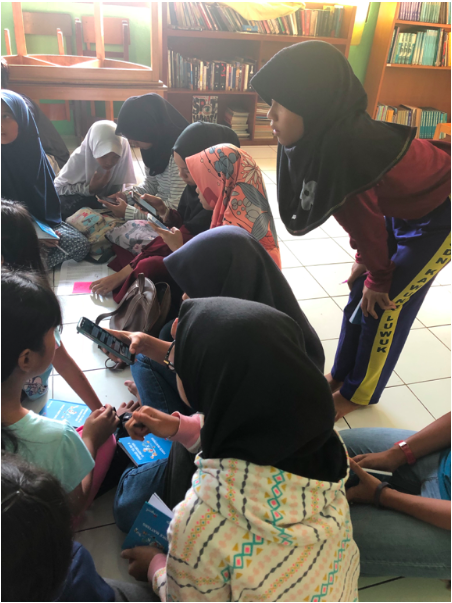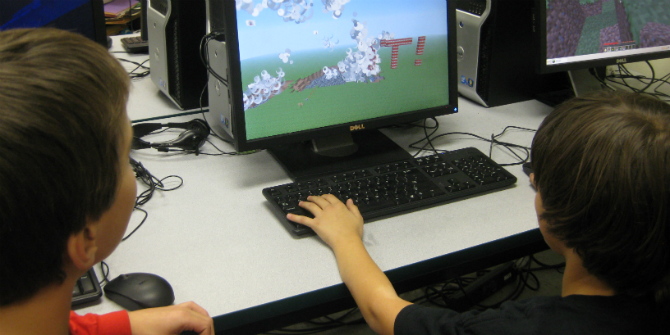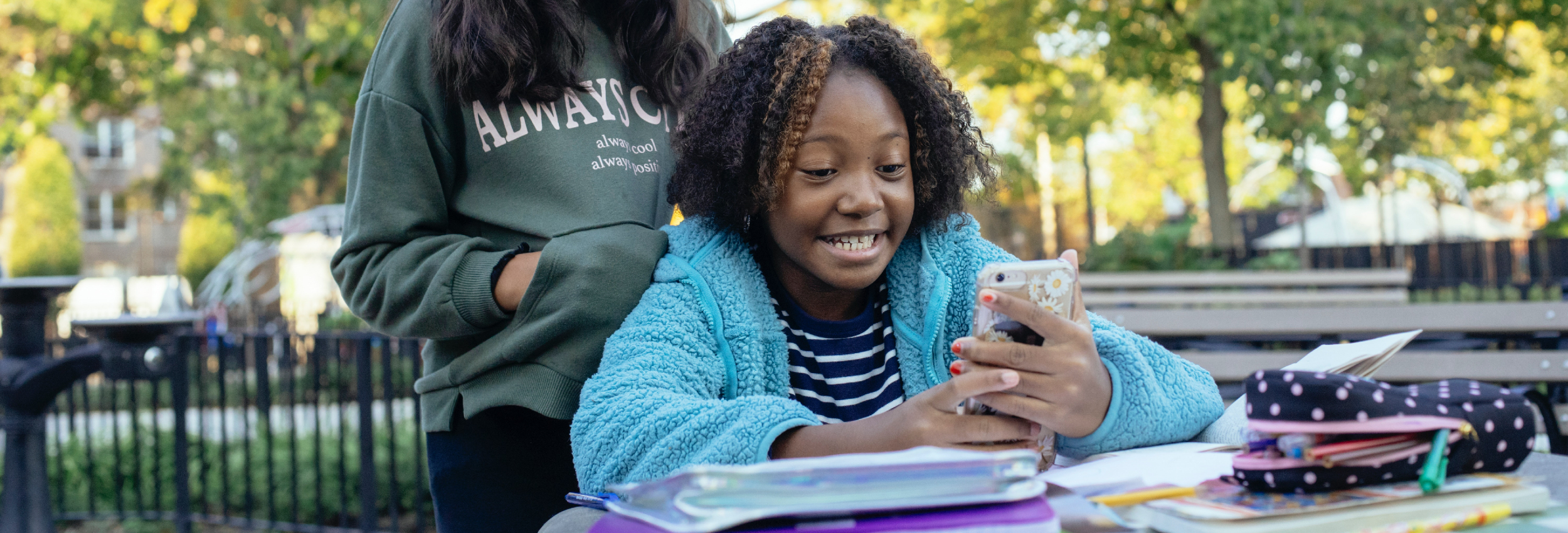 In this blog, Monica Bulger and Patrick Burton report on interviews carried out with marginalised teens in East Asia about what they perceive to be the benefits of social media. This is the first in a series of field dispatch reports conducted by Monica Bulger and Patrick Burton in East Asia for UNICEF’s East Asia and Pacific Regional Office in spring of 2019 [1]. [Header image caption: teenage boys play mobile games while waiting for the mall to open in Jakarta. Credit: Monica Bulger.]
In this blog, Monica Bulger and Patrick Burton report on interviews carried out with marginalised teens in East Asia about what they perceive to be the benefits of social media. This is the first in a series of field dispatch reports conducted by Monica Bulger and Patrick Burton in East Asia for UNICEF’s East Asia and Pacific Regional Office in spring of 2019 [1]. [Header image caption: teenage boys play mobile games while waiting for the mall to open in Jakarta. Credit: Monica Bulger.]
Walking up a dark stairwell into a bright space in Chow Kit, a former red-light district in Kuala Lumpur, we are met by ten smiling teenagers sitting at desks arranged in perfect rows. The after-school programme and shelter is for urban poor, mostly refugees and some street children whose mothers are sex workers. The shelter provides lessons during the day and a safe space to sleep at night.
As we work our way through introductions, it is immediately clear that the teens use as many social media apps as those in the US and in exactly same ways. Aside from Korean dramas and Line (a South Korean app with over 700 million users), they primarily use US apps, and regularly engage with other users in the US, Canada, Australia, and Europe. They rattle off the apps they’d used that week: Instagram is a favourite, Facebook, Facebook Messenger, WhatsApp, YouTube. A four-foot tall 14-year-old wearing a button-down shirt ducks his head and laughs when the other kids enthusiastically describe his YouTube dance moves. He refuses invitations to demonstrate, despite encouragement from the other kids.
When we started our research, we didn’t expect urban poor children to have their own YouTube channels, but they do. Many of the teens we spoke with described opportunities provided by social media apps for connecting with the larger world, meeting new people, sharing their talents, and earning money. At an 800-student refugee school on the outskirts of Kuala Lumpur, a 17-year-old Rohingya refugee with flawless skin and jaw-length hair shares make-up stories on Instagram. In Phnom Penh, a boy with vision impairment enthusiastically shares his singing videos and guitar show, boasting 4,800 followers on TikTok, a Chinese-owned video sharing app.
At a rural after-school programme for underprivileged children outside Jakarta, a 16-year-old describes her online store. She uses WhatsApp and Line to promote the dresses she sells. She saw her older sister making money online, so started selling clothing, too. She takes us through how to use WhatsApp stories as a promotional tool. Her story is similar to a teen in Cambodia who uses WhatsApp to sell hairclips. A 16-year-old boy at a pesanthran Islamic boarding school in rural Jakarta develops and sells lessons in Qur’anic verse.

Back at the large refugee school near Kuala Lumpur, several of the teens trade their gaming skills for in-game money. The topic of gaming raises issues of access. Talking about the popular app Fortnite, a 14-year-old refugee from Afghanistan says, “Fornite you can’t play on these phones, you need a very good phone.” He grins, “I’ll play it in the future maybe, it’s in the planning.” When we talk about creating stuff through social media, a few classmates nod toward a tall boy sitting near the head of the table. He says he used to have a YouTube channel for gaming strategies. “Used to,” he says again, quietly, and changes the subject. “He’s really good,” two of his classmates say. Later, he and his friend explain that for now, they only play games on their phones as they lack the equipment they used to have. While the teens don’t dwell on specifics, our conversation often touches on the things they had to leave behind as refugees.
We don’t speak about their journey, but social workers share the difficulties these children have faced in leaving behind their homes, their communities. None of the children have desktop computers, or laptops, or Xboxes. While their families are allowed to live in Malaysia, their parents cannot work, no one can access social services. The school they attend is a private Christian school and is filled to capacity with refugee children.
Another girl shares her drawing online, sometimes responding to online challenges to draw something within a minute, 15 minutes, an hour.
In a Jakarta classroom, teens share the ways they use Growtopia, a world-building game similar to Minecraft but with a farming focus, to buy and sell items in game. One girl shakes her head, saying she also loses money in the games and this experience seems universal for her classmates.
Leaning against a vivid green wall in her middle school’s auditorium, a 14-year-old at a high school in Kuala Lumpur gleefully describes the fiction she shares within the online writing community of WattPad. When asked what kind of fiction she writes, she grins, straightening her glasses, and says “romance, of course.” Her classmates giggle. We’re sitting under a bright Hindu mural, in the Indian section of Kuala Lumpur, all of the girls wearing white shirts and blue pinafores. None of the other girls in the group create things online, which is typical, not just in Malaysia, but globally. A majority of internet users engage in the entertainment and communication dimensions of social media: game play, connecting with people, and looking up information. Referred to as the “ladder of opportunities,” fewer users move up the ‘higher rungs’, creating videos, writing original material, creating art, or leveraging social media to engage in local political or social events.
In all four countries, teens speak of learning English across their social media apps, especially through game chat and YouTube and Netflix videos. Many use language instruction apps like Duolingo as well. In the refugee schools, English is the language of instruction and social media use helps the teens practice and learn.
At the refugee school in Kuala Lumpur, refugees from Afghanistan and Pakistan talk about watching science videos. Across the table, another boy excitedly says “NASA!” and then they launch into a loud discussion of planets and space travel. At the other end of the table, a girl kicks her feet in the air beneath her seat as she talks about the drawing videos she watches, another describes cooking shows: “You know what is happening all over the world, even though you’re not there. For example, Instagram, people will post all over the world, like here is good food, and you can check it out.”
Apparent in these discussions is that, regardless of socio-economics, most children have smartphones and are always connected. Even in schools that do not have running water, or families where their parents are excluded from working due to refugee status, kids pulled out their smartphones to look up information or demonstrate how they used apps. The most popular apps are primarily US apps and most communication is happening in English.
No matter religion, culture, or geography, discussions of why kids enjoy social media inevitably include Kylie Jenner, Ariana Grande, K-pop, and shooter games. Whether for communication, meeting new people, entertainment, or profit, the kids we spoke with are leveraging the opportunities provided by social media and taking the best of each app. With a global reach to the world’s most vulnerable children, Google and Facebook, along with other corporations managing popular social media apps must take their responsibility toward these young users seriously and shift from a focus on limiting their own liability to proactively ensuring that their profit-focus does not expose children to harms.
Notes
[1] Qualitative focus group interviews were conducted April-May 2019 in Kuala Lumpur, Jakarta, Phnom Penh, and Bangkok. 301 social media users aged 11-19 participated. We aimed to include marginalised populations often excluded from this type of research: 121 of our participants were urban poor and included children with disabilities, street children, refugees, juvenile offenders, children exploited in prostitution, and survivors of sex trafficking. We conducted focus group discussions in shelters and other places of care, and in middle and secondary schools, both public and private. Recognising the importance of community and institutions in a child’s life, we interviewed 74 frontline practitioners in the region, including child psychologists and psychiatrists, social workers, counsellors, teachers, principals, and youth activists working with children. We additionally interviewed parents, grandparents, policymakers, and technology providers. Please see our report Our Lives Online: Use of Social Media by Children and Adolescents in East Asia – Opportunities, Risks and Harms for a full description of methods and findings.
This post is also available in audio form as a podcast.
This post gives the views of the authors and does not represent the position of the LSE Parenting for a Digital Future blog, nor of the London School of Economics and Political Science.





